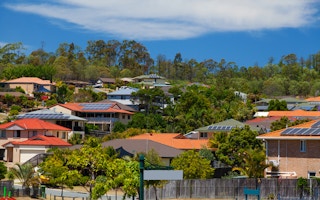Recent blackouts in South Australia have political leaders turning to coal and particularly ‘ultra-critical’ or so-called ‘clean coal’ to fill the power gap in the national electricity grid. The causes of the recent South Australian power failures and similarly close calls in NSW remain the subject of partisan politics, but new coal-fired power stations are not a realistic part of the solution. Here’s why.
The context
Signatories to the Paris Agreement, including Australia, have committed to achieving net zero emissions globally by the second half of the century in order to avoid the worst impacts of climate change. For developed economies like Australia, achieving net zero emissions needs to happen earlier – by around 2050.
Research by ClimateWorks Australia and the Australian National University shows that decarbonisation of the electricity sector is a key element of reaching near or net zero emissions. Essentially this means shifting from coal and other fossil fuels to zero or near zero carbon energy sources such as renewables, coal or gas only if its with carbon capture and storage (CCS) or nuclear power.
A near carbon free electricity system can then be used to decarbonise other sectors by replacing petrol in cars and gas in buildings and some industrial processes.
According to the Intergovernmental Panel on Climate Change, a country’s average electricity emissions intensity needs to be between 0.05tCO2e/MWh and -0.03tCO2MW/h by 2050. For Australia, this means reducing emissions from the electricity sector by at least 94 per cent on today’s level.
In the short term, to achieve the Government’s 2030 emissions reduction target of 26-28 per cent below 2005 levels it is likely that the electricity sector will need to achieve greater emissions reductions than other sectors. Analysis by the Climate Change Authority found that emissions in the electricity sector would need to reduce by over 60 per cent to achieve the sector’s appropriate share of a target broadly equivalent to the Government’s national emissions target.

No more than a limited role for coal with CCS in the electricity sector
Our research shows that Australia can achieve the largest reduction in emissions in the most cost effective way by taking the carbon out of our electricity system. The use of coal to generate electricity is simply not compatible with the globally agreed goal of net zero emissions by mid-century (for developed countries).
Much of Australia’s current coal-fired generation (AEMO estimates approximately 63 per cent) is due to be retired by 2036. Replacing these with new coal-fired power stations – which typically have a lifecycle of 40 to 50 years - while emissions from the electricity sector need to be near zero in 35 years, means any new coal power stations will be stranded assets.
Even the latest technologies for coal-fired power generation, being touted as ‘clean coal’, emit about 80 per cent of the emissions of Australia’s existing black coal power stations – about 0.75 tCO2e/MWh.
The only way to achieve lower emissions from coal generation is to ensure power stations are built with CCS facilities. However, even with CCS attached, coal does not achieve zero emissions, only reducing emissions by about 90 per cent.
As our ‘Pathways to Deep Decarbonisation in 2050’ report shows, coal with CCS could make up no more than 7 per cent of the overall energy mix by 2050 for Australia to get to net zero emissions by mid-century. Further, the residual emissions from coal with CCS must be offset somewhere else in the economy.
In our analysis, we assumed that this would happen through carbon forestry. Doing so incurs additional costs of about $7.5/MWh of electricity produced through coal with CCS. This increases the overall cost of the transition, and also requires more land be set aside indefinitely for carbon forestry.
“
While the decarbonisation of our electricity system is a significant transition for Australia, it is achievable.
Alternatives to coal
Our research shows that Australia can continue to prosper if we shift away from coal and other fossil fuels and use lower carbon energy sources. We have some of the world’s best renewable energy resources, far more than we would need to power our economy, including those that could provide baseload capacity such as wave or tidal, geothermal or bio-energy.
In all our scenarios, solar and wind are the most cost effective technologies for at least two-thirds of Australia’s electricity generation in 2050, even when we include the cost of battery storage capacity.
Since our study was released, the cost projections for solar, wind and battery storage have continued to reduce. Recent CSIRO modelling shows that you can achieve net zero emissions by 2050 with over 90 percent of solar and wind energy while maintaining security and decreasing overall system costs and household electricity bills compared to a business-as-usual scenario.
The modelling also shows that if we start now, achieving a net zero emissions grid can actually improve network stability and resilience, through the decentralisation of energy generation and storage
It is also important not to forget the role of energy efficiency, the ‘cheapest fuel’ available. Indeed, many profitable opportunities remain untapped to reduce Australia’s electricity use in homes, commercial buildings and industrial plants.
Our research shows that Australia could halve the energy we use per dollar of GDP by 2050. Improving energy efficiency can reduce overall system costs by removing the need to build new generation and network capacity.
While the decarbonisation of our electricity system is a significant transition for Australia, it is achievable. To achieve the smoothest and cheapest transition we need to ‘backcast’ – that is begin with the Paris target of net zero emissions by mid-century and then determine the steps to get there.
As soon as we adopt this approach it becomes obvious that coal’s role as the backbone of our electricity system is well and truly over.
Amandine Denis-Ryan is Acting CEO and Head of Research, ClimateWorks Australia. This post is republished from ClimateWorks with permission.











